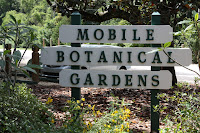Mobile Botanical Gardens, Mobile AL
 The Mobile AL Botanical Gardens are an ideal destination for
winter and spring vacations along the Gulf Coast.
The Mobile AL Botanical Gardens are an ideal destination for
winter and spring vacations along the Gulf Coast.This relatively small public garden has large azalea and rhododendron collections for spring viewing and a significant collection of camellias for an ideal winter visit perfect.
Of the 100-acres that the park holds, 40-acres is set aside
as a woodland park with trails winding among flower beds and distinct garden
spaces.
As of August 1, the garden closes at noon due to the heat in
Mobile.
One of the unique features of the garden is that many of the
paths are wheelchair accessible. The walk from the parking lot to the main
entrance is easy to navigate.
The first planted area visitors see when entering the
property is a demonstration garden from the ReBloom Mobile Project that
showcases plants for home gardens that provide bloom year-round. The paths are
inlaid with local stone placed around a central lawn area.
 The Millie McConnell Azalea and Rhododendron collection holds
over a thousand evergreen Azaleas that wow visitors from March through
June. The original collection is
increased regularly to include everything from the small Robin Hill Azaleas to
the large Southern Indicas.
The Millie McConnell Azalea and Rhododendron collection holds
over a thousand evergreen Azaleas that wow visitors from March through
June. The original collection is
increased regularly to include everything from the small Robin Hill Azaleas to
the large Southern Indicas.This year the Azalea collection was increased to include deciduous Aromi Azalea hybrids. The path then moves toward the plaza that features 19th Century cast-iron columns salvaged from now-demolished, historic downtown buildings.
The Azalea gardens are protected by a wooded glen of
Longleaf Pine Forest and other southern trees that are part of the larger
project to build a restored Lower South habitat for plants and animals.
Longleaf Pine (Pinus palustris) Treasure Forest has a
typical forest floor walking surface. The 35 acre site contains a diverse
ecosystem of 175 vascular plant species and 72 woody plant species. The native
plants that can be observed include: Holly, maple, milkweed, sunflower, aster,
St. Johnswort, dogwood, sedge, spurge, pea, beech, laurel, etc.
Control burns are conducted inside the Longleaf Pine Forest
to manage the undergrowth and to encourage the return of the native wildflowers
each year.
 Another walkable garden was designed in 1970 for the
pleasure of the visually impaired. The shaded pathway is lined with plants with
plants that have textured leaves, scent and other features of interest. The
Fragrance and Texture Garden is now being re-worked after a fireworks fire so
it will be new and improved when you visit.
Another walkable garden was designed in 1970 for the
pleasure of the visually impaired. The shaded pathway is lined with plants with
plants that have textured leaves, scent and other features of interest. The
Fragrance and Texture Garden is now being re-worked after a fireworks fire so
it will be new and improved when you visit.
The Gulf Coast Herb Society maintains a section of brick raised
beds where they have planted herbs with medicinal, culinary and general
household uses. There is an arbor with seating and a fountain that provide a
lovely place to relax.
The garden was founded in 1974 and has developed over the
years thanks to the help of dozens of dedicated volunteers. The gardens near the entrance are paved and
easy to navigate. The Winter Garden is a series of relatively smooth surface
paths that wind through the other gardens.
The International Camellia Society (http://www.internationalcamellia.org/)
awarded the Sawada Winter Garden at Mobile Botanical the Garden of Excellence
Award. When we walked through it this
summer we longed to return during camellia season in January.
The garden was named for Kosaku Sawada who brought a chest
of seeds when he migrated from Japan. The seeds were his wife’s dowry. With
those seeds, Sawada began a career in growing and hybridizing Camellia
cultivars that are credited with changing America’s camellia gardens in the
southern and western US.
 The 50-year collection of Camellias is only part of the
5-acre Winter Garden. This garden also has native azaleas, viburnums, hollies,
magnolias, winter flowering bulbs and other perennials. The 500-members of Mobile’s camellias clubs
work in the gardens, pruning plants, regularly adding new varieties
The 50-year collection of Camellias is only part of the
5-acre Winter Garden. This garden also has native azaleas, viburnums, hollies,
magnolias, winter flowering bulbs and other perennials. The 500-members of Mobile’s camellias clubs
work in the gardens, pruning plants, regularly adding new varieties
.
Overall, this garden is worth a trip! Sad to say, both in person when we visited in May and (when I called in preparation for writing this article) in Aug, the staff interactions left much to be desired. It is clear that visitors and garden writers are seen as a nuisance rather than a gift.
So, definitely go, but plan on a self-guided experience.
Mobile Botanical Gardens 5151 Museum DR Mobile AL 36608
www.mobilebotanicalgardens.org Some paths wheelchair accessible
www.mobilebotanicalgardens.org Some paths wheelchair accessible
251-342-0555



Comments